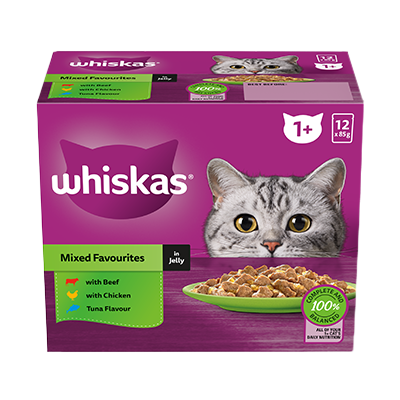
Photo by Maximilian Müller on Unsplash
What Can Cats Taste?
Have you ever noticed your cat gets more excited by one flavour of WHISKAS® food over another? Cats have different tastes and moods, just like we do! So to make mealtimes more enjoyable for both of you, it’s important to learn what they can and can’t enjoy.
The Science of Feline Taste Buds
Over time, cats have developed a slightly more modern palate, but their favourite core flavours are still in line with their wild cat ancestors. Let’s delve into a cat’s anatomy and discover the answer to ‘do cats have taste buds?’.
Anatomy of a Cat's Taste System
Cats have around 470 taste buds compared to our 9,000! These tiny receptors are located on the tip and sides of their tongue, and are designed to detect specific flavours that can help them survive, while rejecting the ones that can’t.
What Cats Can and Can't Taste
Cats can taste umami, which is the savoury flavour found in meat, making protein-rich foods their top choice. But what taste can cats not taste? Believe it or not – cats can’t taste sweetness. Cats are also sensitive to bitter and sour flavours which can help them avoid toxic substances their ancestors would typically find in the wild.
Taste Preferences and Dietary Choices
Cats are natural carnivores, meaning they prefer meat-based diets. This is why you'll often find them purring around a cooked chicken or a WHISKAS® pack. So now you know the answer to the question ‘what flavours can cats taste?’ it’s time to consider another important factor – texture.
Flavour Preferences in Cats
Choosing the right cat food is essential for your furry friend’s health and happiness. Look for high-quality options that list meat as the primary ingredient. While experts have studied what taste can cats not taste, texture is also important. Dry food is a popular choice, while wet food often appeals more because of its smell and hydrating quality, which is great for their kidneys.
Enhancing Your Cat's Dietary Experience
Your cat’s dinner is likely their favourite part of the day. To make the most of their food, check the ingredients list to ensure the first ingredient is a type of meat, like chicken or fish. Consider other ingredients too, and try to avoid fillers like corn or soy, which don't provide the nutrients they need to lead a healthy, active life.
Selecting the Right Cat Food
There are a few factors to consider when choosing the right food for your cat outside of their taste preferences. While some cats are fussy, others may have allergies or sensitivities. Always check with your vet if you're not sure. They’ll be able to explain what flavours can cats taste and how to meet their nutritional needs.
Tips for Picky Eaters
Got a picky eater on your hands? Don't worry, it's more common than you think. A common question among cat parents is what flavours can cats taste if they’re fussy. Try warming up your cat’s food to enhance its aroma or mix up their routine with different flavours like WHISKAS® FAVOURITES range and textures.
Make sure to keep experimenting with different foods to see what makes your cat purr the most. After all, a happy cat means a happy home!
Check out our Guide to Purrr-fect Living!
©2024 Mars or Affiliates.








